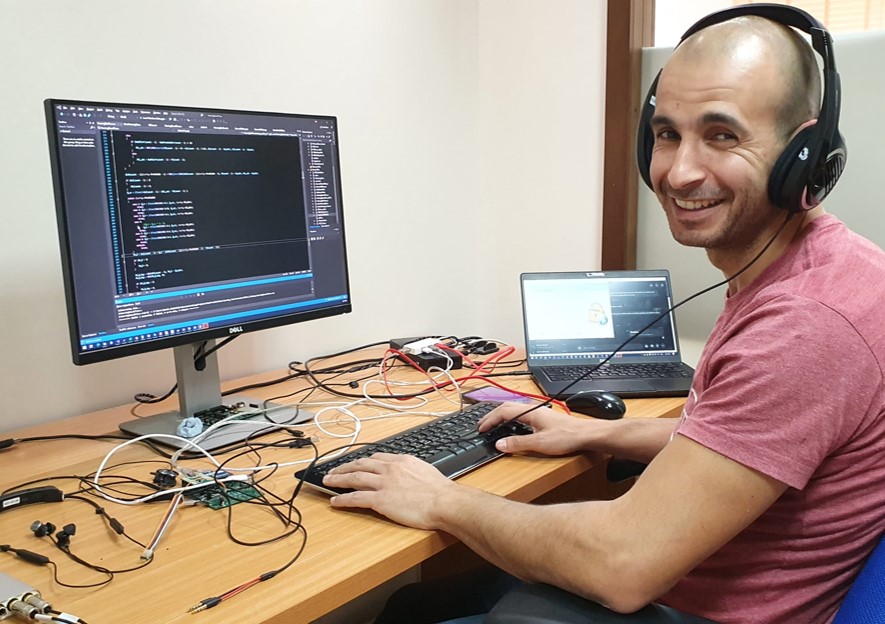Hear better with BeHear EasyListen™ technology that slows down speech in real time
“Leave your name and number at the tone. S l o w l y.”
Susan’s father is in his 80s. His mind is sharp. He has no problem using his mobile for phone and even video calls. Unlike the younger generation, he still uses voicemail, wants to listen to messages and call people back. That’s why he recorded a special message for people trying to reach him, requesting they leave their number, speaking slowly.
Having to strain to catch what someone else is saying is both annoying and stressful. This phenomenon is not necessarily a function of a hearing problem (although it may be). Some people are simply “fast talkers,” people who speak more quickly than most, making it hard to catch everything they say. There are several additional situations where rapid speech could be a problem that makes us wish it were possible to slow down the words of the person on the other side of the phone:
- Age – As we age our reflexes become slower. In the same vein, the gap between hearing and comprehension increases i.e., it takes more time for the brain to process the sound and translate it into meaning.
- Geography – In the U.S.A, for example, the southern drawl is very different from the clipped speech of a New Yorker. The trend to use offshore employees for customer support introduces unfamiliar accents. When someone sounds different than what we are used to hearing, their speech is harder for our brain to process.
- Language – different languages are spoken at different paces, and it can be challenging to keep up with a conversation that is not in your native tongue.
EasyListenTM technology is integrated into BeHear hearing amplification headsets, enabling users to slow down speech during mobile calls and while listening to voice messages.
For people experiencing even mild hearing loss, EasyListenTM technology to slow down speech can be particularly helpful. Hearing degradation affects our ability to hear certain sounds that make up words, such as the letters and letter combinations f, s, sh, th, etc. In this case the brain needs extra time to determine what was said, based on overall context. In such cases, people often find themselves unduly tired without realizing that this is caused by the added strain and stress of trying to decipher words that have become unclear.
“Time stretching” technologies for speech modification are not new. EasyListenTM differs from these, creating a more complex and intelligent standard for the dynamic real-time control of speech. Sophisticated speech analysis is performed, and only those parts that are important for understanding, but just too fast, are slowed down to the extent that is necessary. This is how the speech is slowed down, without altering the natural feel of the conversation:
- Natural pauses occur in each typical conversation (such as when the speaker takes a breath). Shortening such pauses is used to reduce the delay that is generated by slowing down the audio signal. However, if the speaker talks fast continuously, with no pauses, EasyListenTM will gradually stop slowing down his/her monologue when the maximal allowed delay is exceeded.
EasyListenTM technology is language-independent and works equally well with Western and Eastern tonal languages. It can be activated during mobile (cell) phone calls only, not during live conversations or television/movie viewing.
BeHear hearing amplification headsets are designed to help make life sound better, particularly for people with mild to moderately-severe hearing loss. There are numerous benefits to reducing the strain of trying to hear or trying to keep up with someone who is simply speaking too fast, including: stress reduction, increased well-being, and more pleasant interpersonal connections.
From the iPhone to BeHear: Why, as an audiologist, I decided to also become an engineer
Suhail explains his journey and how BeHear hearing technology bridges the gap between audiology and smartphone technology with an app that gives the user control over their hearing.
When the first iPhone was released, back in 2007, I envisioned a revolution in my field of audiology. If it would be possible to connect between the mobile phone and hearing aids, this could create new hearing technology and empower hearing aid users in a completely new way – instead of being completely dependent on the audiologist to tune their device, users could access some of the technological features and control their own hearing definitions.
The smartphone industry began to flourish, and it was obvious to me that, as a result, hearing rehabilitation and the hearing aid industry would forever change.

My name is Suhail Habib Allah and I am an audiologist. I am also an electrical engineer with a specialty in software programming. My dream was to bridge the gap between audiology and technology and develop a device that empowers the user with more control over their hearing while providing high-fidelity sound.
Enter, BeHear.
In 2015, I joined Alango Technologies and took a leading role in the development of the BeHear product line: hearables that provide cutting edge hearing technology at minimal effort for the user. BeHear hearing amplifiers are powerful, professional hearing enhancement solutions.
BeHear devices are a combination of a hearing amplification headset and a dedicated app that enables user control over sound definitions. The app walks the user through the set up and fine tuning of what he or she hears. Front end algorithms were incorporated to improve the SNR (Signal to Noise Ratio) in complex listening situations. Hearing mode presets were designed to help the user switch between different modes in real time.
The core of the app and the element on which the sound customization is based is our hearing test. Accurate hearing screening has always been the foundation of successful rehabilitation and device fitting, it’s no different for BeHear. Our innovation is putting a professional quality screening tool in the hands of the user. We knew that the customization capabilities would differentiate our offering. That’s why we invested a lot of time developing the hearing test, putting it through extensive field testing and fine tuning of capabilities before its release.
In the second stage of BeHear development, we worked on the fitting formula. Our goal was to deliver crystal clear, sharp sound, providing users a comfortable sound range, thus reducing listening strain and enabling comfortable use for extended periods of time.
We developed a fitting formula based on equalization of the of the loudness dynamic range across the frequency spectrum, giving more weight and emphasizing the high frequencies – especially in the region 2-4 KHz. This formula, combined with some of the company’s proprietary technology, resulted in an industry-disruptive assistive hearing device with clear advantages:
- high end sound enhancement features – the quality of a hearing aid in the form of an easy to adopt hearable;
- disrupting the process of getting a hearing rehabilitation device – reducing the timeframe between when a person recognizes that he or she needs hearing help and getting a device can be significant in preventing further hearing degradation, in addition to maintaining quality of life. The old, complex and prolonged process is replaced with a new streamlined option;
- gives the users more independence and control – this is important for emotional wellbeing!
- affordable – cost is known to be one of the significant barriers in adopting hearing aids. BeHear makes quality hearing accessible to all.
It’s been over a decade since I first began this journey. Learning to be an engineer as well as an audiologist enabled me to realize my vision of leveraging technology to create a new hearing experience. It also provided me the opportunity to play a significant role in the development of BeHear, which is making life sound better for people, worldwide.
Written by Suhail Habib Allah, BeHear Chief Audiologist
Let’s talk on LinkedIn
Follow us on social media
Wear & Hear Featured in Hearing Technology Showcase
“These are not your grandpa’s hearing aids.”
♦ Vicki Dean, writing for the Herald-Tribune, recently interviewed spokespersons for companies showcasing their solutions at the Hearing Tech Expo, held February 15 at the Manatee Technical Institute in Bradenton, Florida.
In its eighth year, this event is sponsored annually by the HLAA Sarasota chapter. Hundreds attended to take advantage of free hearing clinics and workshops, to meet with various support groups, and to try out the latest in hearing health technology.
As first-time exhibitors at this event, we at Wear & Hear were honored to be interviewed by Ms. Dean, and mentioned in the subsequent article in the Herald-Tribune. Our products caught her eye when we launched the BeHear ACCESS, a personalizable hearing headset, at the CES 2020 event earlier in the year.
Of the new technologies showcased at the event, Ms. Dean wrote:
These are not your grandpa’s hearing aids…New devices function like Bluetooth headsets to amplify relevant sounds while filtering out background noise.
To get our stories sent directly to your inbox, register here.
